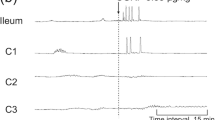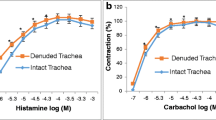Summary
Capsaicin (10−9 to 10−5 M) contracted guinea-pig tracheal strips. Epithelium-containing tracheal strips developed a maximum active tension which was significantly higher than that observed in epithelium-free strips. Anti-CGRP (calcitonin gene-related peptide) serum blocked the epithelium-dependent potentiation of the capsaicin-induced contraction in the intact tracheal strips, without affecting the response of the epithelium-free strips. This result suggests the occurrence of an epithelium-dependent release of CGRP. This same serum markedly reduced the contraction induced by exogenous rat CGRP in both intact and epithelium-free tracheal strips. In epithelium-free tracheal strips, capsaicin-induced contraction was abolished by spantide (10−6 and 10−5 M), a substance P antagonist, but, in intact tracheal strips, spantide did not abolish the capsaicin-induced contraction, showing that both CGRP and substance P release are directly induced by capsaicin. Moreover, the contractile responses to rat CGRP of intact tracheal strips from guinea pig suggest that CGRP itself might be able to release a contracting factor from the airway epithelium. Therefore, CGRP originating from the airway epithelium may play a major role in the control of airway smooth muscle tone.
Similar content being viewed by others
References
Buck SH, Burks TF (1986) The neuropharmacology of capsaicin: review of some recent observations. Pharmacol Rev 38:179–226
Bucsics A, Lembeck F (1981) In vitro release of substance P from spinal cord slices by capsaicin congeners. Eur J Pharmacol 71:71–77
Cadieux A, Springall DR, Mulderry PK, Rodrigo J, Ghatei MA, Terenghi G, Bloom SR, Polak JM (1986) Occurrence, distribution, and ontogeny of CGRP immunoreactivity in the rat lower respiratory tract: effect of capsaicin treatment and surgical denervations. Neuroscience 19:605–627
Das RM, Jeffery PU, Widdicombe JG (1979) Experimental degeneration of intra-epithelial nerve fibres in cat airways. J Anat 128:259–267
Flavahan NA, Aarhus LL, Rimele TJ, Vanhoutte PM (1985) Respiratory epithelium inhibits bronchial smooth muscle tone. J Appl Physiol, 58:834–838
Hamel R, Ford-Hutchinson AW (1988) Contractile activity of calcitonin gene-related peptide on pulmonary tissues. J Pharm Pharmacol 40:210–211
Holzer P (1988) Local effector function of capsaicin-sensitive sensory nerve fibres endings: involvement of tachykinins, calcitonin gene-related peptide and other neuropeptides. Neuroscience 24:739–768
Hoyes AD, Barber P, Jagessar H (1981) Effects of capsaicin on the intraepithelial axons of the rat trachea. Neurosci Lett 26:329–334
Jancso N, Jancso-Gabor A, Szolcsanyi J (1968) The role of sensory nerve endings in neurogenic inflammation induced in human skin and in the eye and paw of the rat. Br J Pharmacol 33:32–41
Kao CY (1966) Tetrodotoxin, saxitoxin and their significance in the study of excitation phenomena. Pharmacol Rev 18:997–1049
Lembeck F (1983) Sir Thomas Lewi's nocifensor system, histamine and substance P-containing primary afferent nerves. Trends Neurosci 6:106–108
Lundberg JM, Saria A (1982) Bronchial smooth muscle contraction induced by stimulation of capsaicin-sensitive sensory neurons. Acta Physiol Scand 116:473–476
Lundberg JM, Saria A, Brodin E, Rossell S, Folkers K (1983) A substance P antagonist inhibits vagally-induced increase in vascular permeability and bronchial smooth muscle contraction in the guinea pig. Proc Natl Acad Sci USA 80:1120–1124
Lundberg JM, Franco-Cereda A, Hua X, Hökfelt T, Fisher JA (1985) Coexistence of substance P and calcitonin gene-related peptide-like immunoreactivity in sensory nerves in relation to cardiovascular and bronchoconstrictor effects of capsaicin. Eur J Pharmacol 108:315–319
Maggi CA, Santicioli P, Theodorsson-Norheim E, Meli A (1987) Immunoblockade of response to capsaicin in the rat vas deferens: evidence for the involvement of endogenous calcitonin gene-related peptide. Neurosci Lett 78:63–68
Naharashi T (1974) Chemical as tools in the study of excitable membranes. Physiol Rev 54:813–889
Palmer JB, Cuss FM, Mulderry PK, Ghatei MA, Springall DR, Cadieux A, Bloom SR, Polak JM, Barnes PJ (1987) Calcitonin gene-related peptide is localised to human airway nerves and potently constricts human airway smooth muscle. Br J Pharmacol 91:95–101
Rosenfeld MG, Mermod JJ, Amara SG, Swandson LM, Sawchenko PE Rivier J, Vale NN, Evans RM (1983) Production of a novel neuropeptide encoded by the calcitonin gene via tissue specific RNA processing. Nature 304:129–135
Saria A, Lundberg JM, Hua X, Lembeck F (1983) Capsaicin-induced substance P release and sensory control of vascuuaal permeability in the guinea pig ureter. Neurosci Lett 41:167–172
Springall DR, Polak JM, Ghatei MA, Lackie P, Bloom SR (1984) Calcitonin gene-related peptide (CGRP), a new regulatory peptide widely distributed in lung. J Pathol 143:306–307
Stuart-Smith K, Vanhoutte PM (1988) Airway epithelium modulates the responsiveness of porcine bronchial smooth muscle. J Appl Physiol 65:721–727
Szolcsanyi J (1983) Tetrodotoxin-resistant non-cholinergic neurogenic contraction evoked by capsaicinoids and piperine on the guinea pig trachea. Neurosci Lett 42:83–88
Tschirhart E, Landry Y (1986) Airway epithelium releases a relaxant factor: demonstration with substance P. Eur J Pharmacol 132:103–104
Tschirhart E, Frossard N, Bertrand C, Landry Y (1987) Arachidonic acid metabolites and airway epithelium-dependent relaxant factor. J Pharmacol Exp Ther 243:310–316
Author information
Authors and Affiliations
Additional information
Send offprint request to E. Tschirhart at the above address
Rights and permissions
About this article
Cite this article
Tschirhart, E., Bertrand, C., Theodorsson, E. et al. Evidence for the involvement of calcitonin gene-related peptide in the epithelium-dependent contraction of guinea-pig trachea in response to capsaicin. Naunyn-Schmiedeberg's Arch Pharmacol 342, 177–181 (1990). https://doi.org/10.1007/BF00166961
Received:
Accepted:
Issue Date:
DOI: https://doi.org/10.1007/BF00166961




